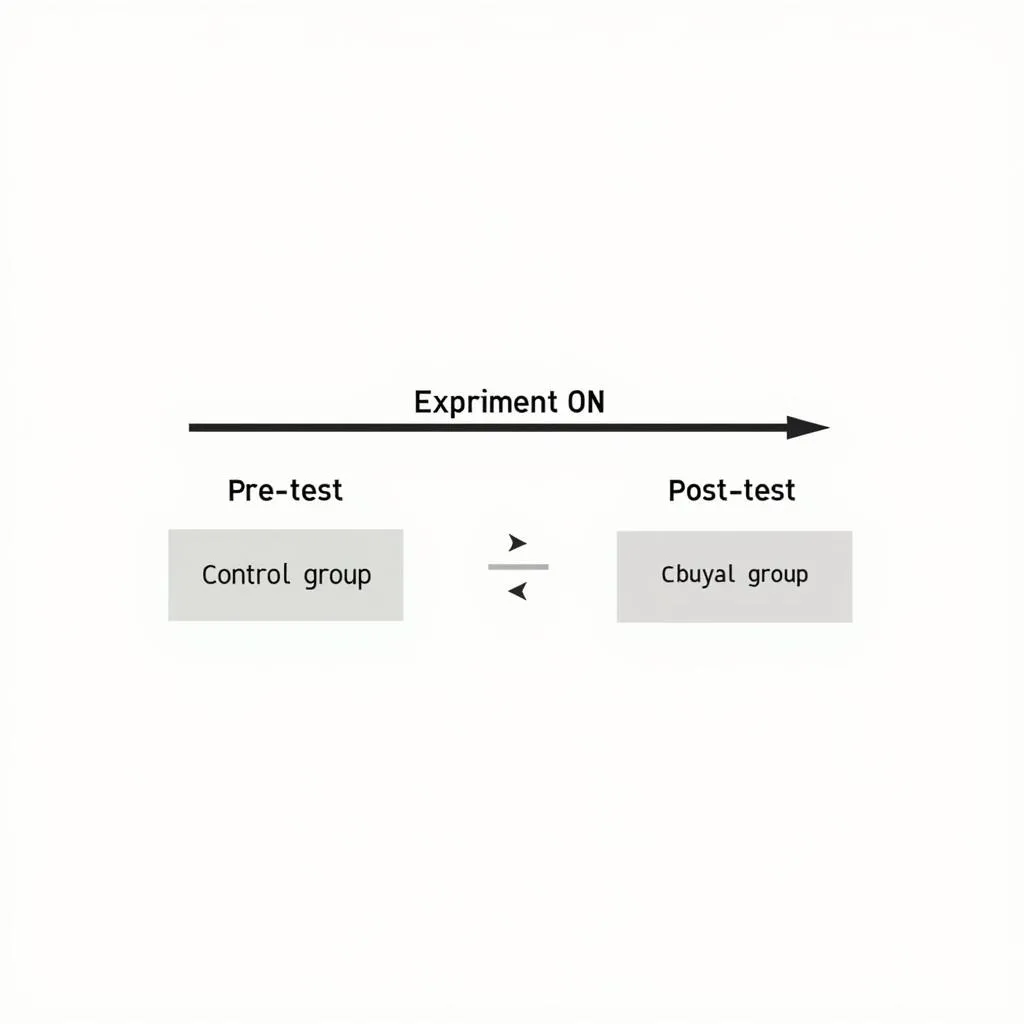Pre-test And Post-test Research Design is a method used to measure the effectiveness of an intervention or treatment. This involves testing a group of subjects before and after they are exposed to a specific variable, allowing researchers to determine if any observed changes are due to the intervention itself. This design is frequently employed in various fields such as education, healthcare, and psychology to evaluate the impact of educational programs, medical treatments, or therapeutic interventions.
What are the Key Components of a Pre-Test and Post-Test Design?
This design typically involves two key components:
- Pre-test: This is the initial measurement taken before the intervention is introduced. It establishes a baseline for comparison and helps to control for any pre-existing differences between participants.
- Post-test: This measurement is taken after the intervention has been implemented. By comparing the pre-test and post-test scores, researchers can assess the extent to which the intervention has influenced the outcome of interest.
Advantages of Using a Pre-Test and Post-Test Design
There are several reasons why researchers choose to use a pre-test and post-test design:
- Establish Causality: By measuring the outcome variable before and after the intervention, researchers can better attribute any observed changes to the intervention itself, rather than other extraneous factors.
- Control for Confounding Variables: The pre-test allows researchers to identify and statistically control for pre-existing differences between participants that might influence the outcome.
- Track Individual Change: This design allows for the tracking of individual changes in the outcome variable, providing a more nuanced understanding of the intervention’s effects.
Different Types of Pre-Test and Post-Test Designs
There are several variations of the pre-test and post-test design, each with its strengths and limitations:
- One-Group Pre-test-Post-test Design: This design involves a single group of participants who are measured before and after the intervention. While simple to implement, it is vulnerable to threats to internal validity such as history, maturation, and testing effects.
- Control Group Pre-test-Post-test Design: This design addresses the limitations of the one-group design by including a control group that does not receive the intervention. This allows for a more robust assessment of the intervention’s effects by controlling for extraneous factors.
- Solomon Four-Group Design: This design further strengthens the control by adding two additional groups: a group that receives the intervention but no pre-test and a group that receives neither the intervention nor the pre-test.
Limitations of Pre-Test and Post-Test Designs
While valuable, this research design has limitations:
- Testing Effects: The act of taking the pre-test itself may influence participants’ performance on the post-test, regardless of the intervention.
- Attrition: Participants dropping out of the study between the pre-test and post-test can skew the results, particularly if the drop-out rate is different between the groups being compared.
- Ethical Considerations: In some cases, it may be unethical to withhold an intervention from a control group, especially if the intervention is known to be beneficial.
 Example of a Pre-test and Post-test Design
Example of a Pre-test and Post-test Design
How to Analyze Data from a Pre-Test and Post-Test Design
The specific statistical techniques used to analyze data from a pre-test and post-test design will depend on the nature of the data and the research question. Common methods include:
- Paired t-test: This test is used when the outcome variable is continuous and the goal is to compare the mean scores of the same group of participants before and after the intervention.
- Independent t-test: This test is used when comparing the mean scores of two different groups (e.g., a control group and an experimental group) on the outcome variable at either the pre-test or post-test stage.
- Analysis of covariance (ANCOVA): This technique allows researchers to statistically control for the pre-test scores when examining the relationship between the intervention and the post-test scores.
Ensuring the Validity of Pre-Test and Post-Test Designs
To maximize the validity and reliability of findings, researchers must carefully consider several factors:
- Randomization: Whenever possible, participants should be randomly assigned to either the intervention or control group to minimize bias.
- Blinding: When feasible, both the participants and the researchers administering the intervention should be blinded to the treatment condition to reduce the risk of bias.
- Sample Size: An adequate sample size is crucial to ensure that the study has sufficient statistical power to detect meaningful differences between groups.
 Ensuring Validity and Reliability
Ensuring Validity and Reliability
Conclusion
Pre-test and post-test research design is a powerful tool for evaluating the effectiveness of interventions. By incorporating careful planning, appropriate statistical analysis, and efforts to enhance validity, researchers can utilize this design to gain valuable insights into a wide range of phenomena. If you are considering conducting research using this design, consulting with an experienced researcher or statistician is highly recommended.
FAQs About Pre-test and Post-Test Design
1. What is the main purpose of a pre-test in this design?
The pre-test provides a baseline measurement of the dependent variable before the intervention, allowing researchers to assess change and control for pre-existing differences between groups.
2. What are some potential threats to internal validity in a pre-test and post-test design?
Threats include history (external events), maturation (natural changes in participants), testing effects, instrumentation (changes in measurement), and attrition (loss of participants).
3. Can a pre-test and post-test design be used with qualitative data?
While typically used with quantitative data, this design can be adapted for qualitative research. For instance, pre- and post-intervention interviews or focus groups can be conducted to explore experiences and perceptions.
4. What statistical tests are commonly used to analyze data from this design?
Common tests include paired t-tests, independent t-tests, analysis of covariance (ANCOVA), and repeated measures ANOVA, depending on the research question and data type.
5. How can researchers minimize the impact of testing effects in a pre-test and post-test design?
Using a control group, employing a longer time interval between the pre-test and post-test, and utilizing alternative forms of the pre-test can help mitigate testing effects.
Need assistance with your Paranormal Research project? Contact us!
Phone: 0904826292
Email: research@gmail.com
Address: No. 31, Alley 142/7, P. Phú Viên, Bồ Đề, Long Biên, Hà Nội, Việt Nam
Our team is available 24/7 to assist you.